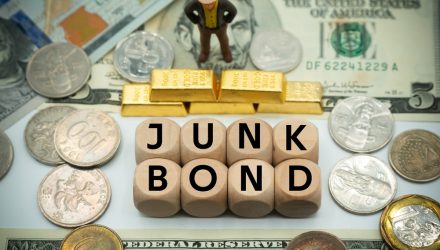Junk bond exchange traded funds have taken a beating this year, and the blows may not let up any time soon.
Year-to-date, the iShares iBoxx $ High Yield Corp Bond ETF (NYSEArca: HYG) declined 10.4% and the SPDR Bloomberg Barclays High Yield Bond ETF (JNK) decreased 10.9%.
Speculative-grade junk bonds have plunged and yields have surged to two-year highs of about 7.5%, MarketWatch reports.
Despite the cheaper valuations in the high-yield bond segment, Rajay Bagaria, chief investment officer at Wasserstein Debt Opportunities, warned that investors should still remain cautious.
“There is a scenario where it all looks pretty cheap right now,” Bagaria, a leveraged finance veteran, told MarketWatch. “There is this possibility of a soft landing. And I think if that happens, you’ll look back and you’ll say: a lot of high yields’ priced down 15 to 20 points in four months. That doesn’t happen very often.”
However, Bagaria underscored several key factors that could further impede a rebound in the high-yield segment, notably the effects of sharp fund outflows this year, with high-yield credit experiencing some of the worst outflows based on assets under management.
“The fact that you are seeing real capitulation in high yield, on specific situations, suggests to us that liquidity is becoming the issue,” Bagaria said. “And when liquidity is the issue, everything is untethered.”
Furthermore, Bagaria noted that there are ongoing risks associated with Federal Reserve interest rate moves, a key driver of negative first-quarter returns. Investors are even taking “false comfort” in economic indicators like a roughly 10% plunge in copper prices from a pandemic peak, a predictor of economic activity.
Bagaria is also concerned about an extended inflationary environment as China reopens from its Covid-19 lockdowns.
Federal Reserve Chairman Jerome Powell has already warned that the central bank’s plan for a soft landing for the economy while wrangling down high inflation, is not entirely in control since the geopolitical risks of the war in Ukraine and coronavirus lockdowns in China can also contribute to the inflationary pressures.
“Until the last week or two, we felt like this was a normal, functioning market, the liquidity premium was still low,” Bagaria added. “You are starting to see now gap-downs in price because people just want to get out of stuff.”
Alternatively, investors may also consider inverse or short junk bond ETFs to further hedge against a dip in speculative-grade debt markets. The ProShares Short High Yield (NYSEArca: SJB) takes the inverse -1x or -100% daily performance of the Markit iBoxx $ Liquid High Yield Index, which acts as the underlying index for HYG.
For more news, information, and strategy, visit the Fixed Income Channel.

